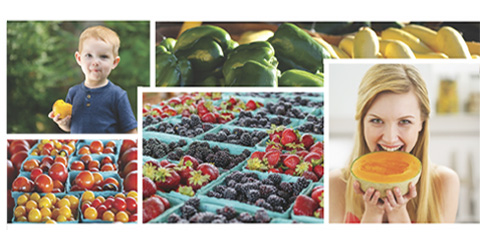Publix is going head-to-head with Harris Teeter in Charlotte, one of the nation’s faster-growing metro areas. Sprouts Farmers Market and Wegmans have entered the Carolinas too. Others include newly-related BI-LO and Harveys banners, both of which have longstanding presences throughout the Carolinas. Piggly Wiggly is also a big player in South Carolina.
One Carolina chain is hoping to turn its grocery stores into a gathering place: Lowes Foods, based in Winston-Salem, is emphasizing the local food experience on a community level. A subsidiary of Hickory, NC food distributor Alex Lee, Lowes is trying out a redesign that features a communal area in the center store. Most of the chain’s locations are in North Carolina, with a dozen or so in South Carolina and a handful in Virginia.
At A Glance: Production Areas
North Carolina
The eastern Coastal Plain, bordering the North Carolina Piedmont Triad, is sweet potato country. About half of the state’s 95,000-acre harvest comes from Sampson, Johnston, Wilson, and Nash counties. Fresh cucumbers and sweet corn ship from large farms in the Blacklands region, eight counties on the Atlantic Coast. The state’s Coastal Plain producers start the season for tomatoes and melons. Henderson County, farther west, leads field tomato production, followed by Burkin County.In southern North Carolina, Bladen County is home to over half of the state’s 7,000 blueberry acres; growers there average 100 acres, but some are much larger. Neighboring Sampson and Pender counties each harvest around 1,000 acres of blueberries. Fresh strawberries are grown throughout the state, on smaller acreages.
South Carolina
Northeastern South Carolina is the main peach production area. Saluda, Spartanburg, and Edgefield counties are ranked first through third in acreage, in that order. Watermelon acreage is concentrated in South Carolina’s low country: Aiken, Allendale, Bamberg, Barnwell, Colleton, and Hampton counties. Chesterfield and Lancaster counties are the main upstate melon areas, according to the South Carolina Department of Agriculture.Lexington County is a production hub for collards, turnip, and mustard greens. It is also a major fresh sweet corn supplier; overall, Lexington bested its sibling counties to lead South Carolina’s overall value in vegetable production.
Elise Wilson, owner of Pal-Agri Company, LLC is in Columbia. “Good schools, good services, lots of natural landscape—it’s just a great place to be,” she shares. The area also has good retail representation including Walmart, Kroger, Trader Joe’s, Whole Foods, and Target.
Buying Trends
Surging population, including younger consumers, is fueling growth in organic, local, and value-added product offerings. Demand for local stretches to both retailers and foodservice. Taylor says numerous restaurants have opened in the last couple years, seeking local produce. Fortunately, with the emergence of more hub and city markets, and smaller growers getting certified, it’s been easier to find and secure local product.



